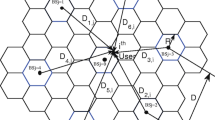Abstract
Link level SINR simulation results and network level sector throughput simulation results that quantify the benefit of dual antenna MMSE reception in a macrocellular WCDMA/HSDPA system are provided. Dual antenna RAKE receiver performance serves as baseline reference. Link-level simulation results are accompanied by a novel analytical expression that in flat Rayleigh fading and for uncorrelated rx-antenna branches describes spatial interference suppression mean SINR gain as function of a dominant other-sector interference ratio (DIR). It is shown that the MMSE receiver’s spatial interference suppression gain heavily depends on the amount of experienced DIR. The higher the DIR the higher the SINR gain. Nevertheless, seen on network level the SINR gain turns into moderate sector throughput gain, well below 50%. This is due to the fact that high DIR situations are rare in the investigated macrocellular scenario. Moreover, the logarithmic relation between SINR and capacity hinders translation of the full SINR gain into HSDPA sector throughput.
Similar content being viewed by others
References
Lozano A., (2002) “Enhancing UMTS High-Speed Downlink Packet Access with Dual-Antenna Terminals”. Global elecommunications Conference 1, 732–736
R. Love, K. Stewart, R. Bachu, and A. Ghosh, “MMSE equalization for UMTS HSDPA”, IEEE 58th Vehicular Technology Conference, Vol. 4, pp. 2416–2420, October 2003.
GPP, “Multiple-Input Multiple Output in UTRA”, Technical Report TR 25.876 (V1.7.0), Technical Specification Group Radio Access Network, August 2004.
J. H. Winters, “Optimum Combining in Digital Mobile Radio with Cochannel Interference”, IEEE Journal on Selected Areas in Communications, Vol. 2, No. 4, pp. 528–539, July 1984.
E. Villier, “Performance Analysis of Optimum Combining with Multiple Interferers in Flat Rayleigh Fading”, IEEE Transactions on Communications, Vol. 47, No. 10, pp. 1503–1510, October 1999.
J. P. Burke, J. R. Zeidler, and B. D. Rao, “CINR Difference Analysis of Optimal Combining Versus Maximal Ratio Combining”, IEEE Transactions on Wireless Communications, Vol. 4, No. 1, pp. 1–5, January 2005.
L. T. Berger, T. E. Kolding, P. E. Mogensen, and L. Schumacher, “Geometry Based Other-Sector Interference Modelling for Downlink System Simulations”, The Seventh International Symposium on Wireless Personal Multimedia Communications (WPMC04), Abano Terme, Italy, Vol. 2, pp. 309–313, September 2004.
T. E. Kolding, F. Frederiksen, and P. E. Mogensen, “Performance Aspects of WCDMA Systems with High Speed Downlink Packet Access (HSDPA)”, IEEE 56th Vehicular Technology Conference, Vancouver, Canada, Vol. 1, pp. 477–481, September 2002.
L. Schumacher, K. I. Pedersen, J.-P. Kermoal, and P. Mogensen, “A Link-Level MIMO Radio Channel Simulator for Evaluation of Combined Transmit/Receive Diversity Concepts within the METRA Project”, Proceedings of IST Mobile Summit 2000, Galway, UK, pp. 515–520, October 2000.
T. E. Kolding, “Link and System Performance Aspects of Proportional Fair Scheduling in WCDMA/HSDPA”, IEEE 58th Vehicular Technology Conference, Orlando, USA, Vol. 3, pp. 1717–1722, October 2003.
R. Vaughan and J. B. Andersen, Channels, Propagation and Antennas for Mobile Communications, IEE Electromagnetic Waves Series. The Institution of Electrical Engineers, London, UK, 2003.
Rice J.A., (1988). Mathematical Statistics and Data Analysis. Wadsworth & Brooks, Belmont USA
Author information
Authors and Affiliations
Corresponding author
Rights and permissions
About this article
Cite this article
Berger, L.T., Kolding, T.E., Schumacher, L. et al. Effects of Dominant Other-Sector Interference on Dual Rx-Antenna HSDPA Performance. Wireless Pers Commun 40, 343–354 (2007). https://doi.org/10.1007/s11277-006-9195-6
Published:
Issue Date:
DOI: https://doi.org/10.1007/s11277-006-9195-6




